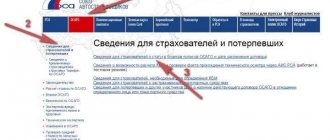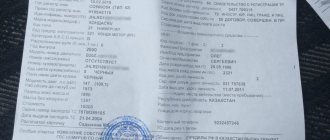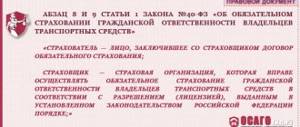What to choose: CASCO or OSAGO?
In fact, modern motorists do not have such a choice, since OSAGO is a compulsory type of insurance. Without such a policy, according to the law, it is prohibited to drive a vehicle.
This is the first key difference between OSAGO and CASCO. The latter refers to voluntarily executed contracts at the discretion of the driver. That is, the car owner may not have CASCO insurance, but compulsory motor liability insurance must be issued.
How much will you have to pay for driving without insurance? Read the article on fines for lack of MTPL insurance
Also, these policies differ in the principle of operation. OSAGO covers the driver's civil liability. For the damage caused, the insurance company will pay compensation to the injured party. CASCO protects the interests of the vehicle owner, allowing him to receive compensation in the event of theft or damage.
Therefore, it is difficult to say which is better - OSAGO or CASCO, each of them serves its own purposes. In this case, the first type of insurance is mandatory; its absence entails penalties.
In the video we compare MTPL, DSAGO and CASCO insurance policies:
Receiving a Refund
Specific compensation criteria are specified in the insurance contract. Each insurance company may have its own.
Basic conditions:
- Damage must be an insured event.
- The policyholder complied with all insurance rules.
The following persons can apply for coverage of losses:
- Insured or beneficiary. The insured may be the driver or owner of the car, or another person who has entered into an insurance contract. The beneficiary is the party to whom the payment is due. If you buy a car on a car loan and have CASCO insurance, the beneficiary is the lender.
- An authorized representative of the policyholder or beneficiary. The insurance company will require you to provide a notarized power of attorney.
- Heirs. In this case, you must have a certificate of inheritance with you.
What does a CASCO policy look like?
The forms may differ from one insurance company to another, but there are a number of required elements:
- security holograms or barcodes containing important information about the driver and vehicle;
- personal data of the holder;
- detailed information about transport;
Click to enlarge
coverage area;- list of risks;
- the amount of the insured amount;
- validity.
The agreement is confirmed by the signatures of both parties and the company seal. The image shows an introductory sample of a CASCO policy from, which is one of the best insurers in Russia.
How to check the policy?
After registration, the representative is obliged to hand over to the car owner the original document, a receipt for payment for services, and insurance rules. You can check the authenticity of CASCO by contacting the official representative office of the company and indicating the vehicle number. If the registration took place outside the office, it is advisable to do this in the presence of an employee immediately after the conclusion of the contract.
How to check the authenticity of a compulsory motor liability insurance policy is described in this article.
Definition and features of an insurance policy
A CASCO insurance policy is a document issued on a special form with several degrees of protection (what does a CASCO policy look like?). Among the key features of the policy, the following can be noted :
- The policy is printed on special paper with watermarks and special fibers “interspersed”.
Some insurers use only one type of protection on their voluntary car insurance policy forms. - The policy must have a “live” stamp and a handwritten signature of the responsible person.
- A unique barcode must be applied to the policy, which is used to quickly determine the authenticity of the form at the insurer’s office.
The policy is the main document in CASCO programs. The policy must contain the following information :
- information about the policyholder and the vehicle that is insured;
- all drivers who are allowed to drive a car are registered;
- all conditions for insurance must be indicated on the policy form;
- the CASCO form must indicate all the risks that are insured as part of the purchased car insurance;
- sum insured: the full value of the vehicle at the time of insurance.
All information must be provided accurately, clearly and without double interpretation.
Among other things, a receipt must come with the CASCO policy . This is an inseparable part of the contract between the policyholder and the insurer, since it is this document that is controlled by the state and serves as confirmation of payment of the cost of CASCO and how much you actually paid.
Important! A receipt is a document of strict accountability. It has its own series and its own number, which do not coincide with the series and number of the CASCO form.
We talked here about whether it is possible to check whether a CASCO policy is valid using the policy number, and from this article you will learn how to check the authenticity of a CASCO policy using the RSA database.
What documents are needed for CASCO?
To issue an insurance policy of this type, you must provide the company with the following package of papers:
- vehicle passport;
- certificate of state registration of transport;
- passport of the policyholder (if he is not the owner, it is also required to provide a power of attorney in his name);
- driver's license of everyone who will be included in the insurance policy.
Documents for application in the event of an insured event
In case of an accident or other situation included in the list of risks, in order to receive compensation you must provide:
- a statement describing the event (in writing);
- insurance policy and driver's license of the person driving the vehicle at the time of the incident;
- documents prepared by a traffic police specialist;
- medical examination protocols (if it was required by the situation and was carried out).
Tariffs for CASCO
Tariff changes are influenced by many factors:
- indicators on thefts of a certain make and model of vehicles in the region;
- the price of spare parts and the cost of a standard hour for maintenance services for a car brand in a populated area;
- period of operation;
- engine power;
- age and driving experience of all car owners;
- their insurance history (frequency of accidents and insurance amounts paid);
- additional policy services;
- type of transport security device;
- form of parking - garage, parking lot or street;
- type of control - left- or right-hand drive.
How to calculate the cost of CASCO?
The price of the policy depends on many factors. In particular, these include the cost and age of transport, and coverage features. The CASCO calculator will help you make calculations in each specific case.
What is included in the insurance case?
The main risks that may be included include damage, death, theft or theft of the car. However, the specific conditions of the circumstances that may lead to situations considered compensable differ depending on the type of policy and the organization.
When can a CASCO payment be denied?
Refusal to compensate for losses is possible if the insurer is ready to prove that the situation does not correspond to the list of risks from the contract. Companies can definitely avoid insurance payments by:
- Availability of overdue insurance premium.
- Serious violation of traffic rules by the driver.
- Notification of the occurrence of an insured event later than the period established by the contract (often no more than 2-3 days).
- Driving while under the influence of drugs or alcohol.
- Lack of documents confirming the occurrence of an insurance situation.
- Driving a vehicle with tires that are out of season.
- Attempts at self-repair before contacting the insurance company.
When should companies make insurance payments?
Unlike compensation for damage under OSAGO, time limits under CASCO are not established by law. Therefore, the exact payment period will differ from one insurance company to another. You can find out in the terms of the contract.
According to statistics, on average, CASCO owners receive compensation in the period from 15 to 30 days after notifying the company about the incident. This period may increase if any documents were not provided on time or there was a delay in drawing up a conclusion on damage assessment.
If the insurance company deliberately delays payment, a pre-trial claim should be filed. In this case, you can rely on the Civil Code of the Russian Federation, which states that the terms of compensation for damage must be within reason. After such a statement, the organization must often fulfill its obligations within seven days.
Risks
It is not always the case that what insurance companies offer their clients will turn out to be as profitable in reality as it appears from advertising offers.
What features and tricks of insurance agents should you pay attention to so that the contract works for the car owner in the event of certain troubles:
- franchises. An insurance company employee may offer to reduce the cost of the policy by including in the contract an item such as a deductible, which is a fixed amount or expressed as a percentage of payments.
In the first case, if the amount of damage is not estimated higher than the figure specified in the contract, the client does not receive compensation. In the second, he receives payments minus the franchise percentage shown in the contract.Often, car owners do not clarify all the features of the offer and are then forced to spend more.
- Taking into account the wear and tear of the car. In many insurance companies, this factor can significantly reduce the cost of the policy.
But it is worth considering that when receiving payments for an insured event, the amount of depreciation - wear and tear - is deducted from them. Both the make and age of the car, as well as the conditions of the insurance company, are taken into account. - The presence or absence of a vehicle inspection certificate. Despite the fact that in many contracts the condition for its availability is not mandatory, it is worth taking care of this document in advance.
For example, in the event of an accident, injured third parties receive compensation from the insurance company, but in the absence of a maintenance ticket, the organization has the right to sue its client to reimburse the payments made.
Registration of CASCO insurance is becoming an increasingly popular measure to protect car owners from unexpected expenses associated with their vehicle.
What is a CASCO franchise?
This type of policy allows you to significantly reduce the price of car insurance due to the fact that when signing the contract, the client undertakes to bear a certain part of the costs. For example, if we are talking about CASCO with a franchise of 15,000 rubles, the vehicle owner undertakes to independently pay for repairs within this amount. And expenses above this amount are borne by the insurance company.
The essence of such a policy is not only to provide an opportunity to save money, but also to minimize the frequency of claims to the insurer regarding minor damage.
Information about the deductible and its exact amount must be indicated in the CASCO policy.
Usually, a corresponding note about it is made immediately in the field describing the risks under the contract.
At the same time, drivers have the opportunity to use a franchise from the second case, if one is offered by the insurer of their choice. The essence of this option is that upon the first occurrence of an insured event, the owner can count on full compensation for the damage. But for the second and subsequent requests, he will have to independently pay the amount of expenses specified in the agreement.
Franchise classification
Lawyers draw the attention of citizens that, depending on the characteristics of the franchise, the following types are distinguished:
- Conditional. Provides full compensation if the amount of losses significantly exceeds the deductible. For example, it is 10,000, and the damage reaches 40,000. In this case, a citizen can count on the entire 40,000 rubles. It is extremely rare.
- Unconditional. Most often used. Implies a reduction in payment by a specified amount. For example, if a compensation of 40,000 rubles is assigned, and the deductible under the contract is 10,000, then the driver will receive 30,000.
- Aggregate. This type is characterized by a reduction in the franchise size depending on the number of requests. For example, it was agreed upon in the amount of 30,000. Restoring a car for the first accident requires 15,000 rubles, the owner does not receive anything from the insurer. But when applying for the second time, he can expect that his deductible will decrease by the amount he previously paid (15,000). That is, having received damage a second time, he will be able to spend less of his money. For example, the amount of losses will be 40,000. He will no longer have to pay 30,000, but only 15,000. The insurance company will contribute the rest. On subsequent calls, she will also reimburse everything, since the deductible for the two previous times has already reached zero.
With or without a franchise - what to choose?
Advantages and disadvantages of a policy with a deductible
pros
Among the significant advantages of this policy is the opportunity to save on its purchase. The larger the franchise size, the lower the cost of CASCO insurance.
This option also allows you to legally avoid wasting time dealing with minor damage. As mentioned above, insurance organizations may refuse to pay if you attempt to repair it yourself. But if its price does not exceed the franchise amount, then there will definitely be no problems in eliminating the consequences of a minor incident.
Minuses
The disadvantages include the need to independently compensate for part of the losses if an insured event does occur. Also, the disadvantages of CASCO with a franchise include the fact that when taking out a car on credit, the bank is unlikely to approve such a policy. Most likely, he will refuse if he tries to conclude this type of agreement with any insurer.
Cases
The most common insurance situations, such as theft, various damages from third parties, road accidents, intentional damage by evil neighbors, etc., raise virtually no questions among experienced car owners.
It’s another matter when a problem occurs with the car, but it is difficult to determine whether it is covered by at least one insured event provided for in the contract.
For example, it is not clear what to do if your car is completely frozen in ice and there is no way to use your transport before spring? What if your car is very much loved by pigeons?
If you damaged the car yourself
In the understanding of most people, a road accident is an incident in which there are two or more participants. However, sometimes situations arise in which there is a fact of an accident, but there is only one participant - the owner of the car.
An example of such a case could be a collision with an obstacle on the road, as a result of which the vehicle was damaged. In this case, can you count on covering repair costs through a CASCO policy?
To answer this question, here is a list of cases that most insurance companies consider to be an accident involving one person:
- if the car collided with a traffic light, pole or tree, stop for route modes of transport;
- when driving into a hole, a rut resulting from the lack of asphalt in the traffic lane, or an open sewer manhole;
- when hitting a small obstacle, for example, a curb, if it was out of sight for one reason or another;
- if the car was thrown into a ditch;
- if there is an impact on large stationary objects. Examples - a fence, a store window;
- as a result of incorrect entry into the garage, the mirrors or sides of the car were damaged;
- entering a small obstacle. An example is trash cans;
- when hitting nails, ice or other sharp objects;
- if the insured car was standing but was damaged as a result of a collision with the open door of a moving vehicle.
In these cases, with the correct registration of the incident with the help of a traffic police officer or using eyewitness testimony in simpler situations, you can easily receive payments under the CASCO insurance policy.
Dent on the car
If a dent occurs on your car, it is not always possible to receive compensation for repairs under CASCO.
These payments will not raise any questions if the dent was caused by an accident , which is confirmed by the relevant papers from the traffic police officer. They will serve as sufficient grounds for defining the situation as “damage”.
It’s another matter if the dent appeared on the car not in the presence of its owner. The only option in which you can receive payment from the insurance company is to contact the traffic police to record the fact of the damage received.
The most common reasons for refusal of payments by insurance companies:
- lack of official documents about the incident - certificates;
- the formation of the dent occurred as a result of parking in places prohibited under the terms of the contract;
- the dent was received while parking in the wrong place;
- if compensation for damage of this kind was not specified in the contract.
We talked about what to do if the insurance company decides not to pay compensation under the contract here.
Reasons for refusing reimbursement
Let's consider common grounds for refusal to cover damages:
- the situation does not fall under the terms of the insurance contract;
- the driver or passenger was injured, not the vehicle;
- the insured vehicle was damaged purposefully by its owner or a person authorized to drive it;
- the car was damaged while being driven by a driver who is not included in the policy or does not have a driving license;
- vehicles were damaged when used as non-personal transport (taxi services or for driving lessons);
- the motorist was under the influence of alcohol or drugs;
- the defect occurred due to normal wear and tear;
- the true reasons for the insured event were hidden;
- the policyholder did not fulfill the obligations specified in the contract and conditions;
- the insured incident occurred after the expiration of the validity period of the insurance contract.
CASCO: abbreviation decoding
Motorists in most cases decipher the abbreviation as follows :
- complex;
- automobile;
- insurance;
- except;
- responsibility.
Now it’s worth considering in more detail each point of the abbreviation of the CASCO concept.
this type of insurance, CASCO, comprehensive because it allows you to count on insurance payments for several possible risks at once, and not just one. Risks are very common when operating a car.
The owner receives payments when there has been a recorded fact of theft of the car , or its damage. It should be added that CASCO does not include agreed liability for the purpose of financial compensation to others or the loss of goods contained in the vehicle.
The second letter of the abbreviation means “automotive”.
So this insurance can be called conditionally, because, as mentioned earlier, compensation payments are provided to the same extent in case of an insured event that occurred with the participation of such types of transport as:
- trains;
- vessels;
- carriages;
- locomotives;
- aviation transport.
However, other types of transport other than cars are less common; accordingly, insurance companies focus on compensation payments to car owners, this fact is reflected in the abbreviation of the CASCO insurance product.
Such components of the abbreviation as “Insurance” and “In addition” do not require special decoding. But we need to talk about responsibility in more detail.
Liability provided for under CASCO
In case of damage caused, compensation to the car owner is paid in full , and it is worth saying that in this case the factor of his guilt does not play any role. And it also applies when the car was subject to damage due to the fault of third parties or was damaged due to a fire or some other natural disaster. But there is a caveat, which is that for possible additional risks, insurance must be taken out separately from the main one, and its cost will not be very high.
How to convince your insurance company that you are a really good driver?
Youth and short driving experience do not mean that a person drives carelessly. Young, inexperienced drivers may also be known for their careful and risk-free driving.
This is where modern technology comes to the rescue. Insurers have begun to offer “smart insurance”, which is based on telematics technology. The car is equipped with a special transmitter that is connected to GLONASS and GPS. Moreover, the device is provided free of charge; you need to pay the cost of its installation and a subscription fee.
The sensor monitors the driver's driving behavior for several months. He is interested in the degree of aggressiveness of driving: how hard the driver brakes, what speed he maintains, or how smoothly he drives. At the same time, insurance companies claim that the sensor does not record the driver’s location.
You can install a special program on your insurance smartphone in which you can monitor the accrual of points, which determine the discount on the next payment.
However, it is still better to check with your insurance company about the criteria for accidental driving. Many people have a different period of time during which they need to drive with the device. Some require one or two months, while others require six months or more.
Also, some insurance companies evaluate only driving style, while others evaluate the time spent behind the wheel per day, the kilometers traveled and, for example, whether the driver often leaves during rush hour.
Similar systems, borrowed from Europe and the USA, often do not take into account some of the peculiarities of driving in Russia. For example, a driver may be forced to urgently turn the steering wheel or brake sharply because of a hole in the road that was not visible. At the same time, this will be a serious disadvantage for the insurance company.
The size of the discount for non-aggressive driving can be very large, however, the insurance requirements can be quite strict.
There are insurance companies that use “smart comprehensive insurance” and telematics not only to determine driving style, but also to set conditions that suit this particular driver. Thus, there are offers on the market according to which a driver can receive a discount if, for example, he drives at a certain time in a certain area of Moscow. A special sensor will again record its movements. Anything that goes beyond these conditions is considered a non-insured event.
Complaint in case of disputes with the insurance company
If a conflict situation arises between you and the insurer, the first step is to try to resolve the dispute out of court. First, file a complaint with your insurance company. This can be done in person at the office or by calling the claims registration service number. The complaint is drawn up in free form.
ATTENTION!
A financial expert examines controversial situations of insurers and their clients in a pre-trial manner free of charge.
The trial period lasts up to 30 days. If the decision does not suit the insurance company or the car owner, they have the right to challenge it in court.
What to consider when choosing a policy
When choosing the type of CASCO insurance, you need to take into account a number of nuances that affect the completeness of vehicle protection.
These include:
- A set of risks. You don't always need the maximum, but the minimum may not work either.
- The procedure for receiving compensation, money or free repairs. Here, what is more convenient for whom.
- Rules for making changes to the current contract.
- Possibility of early termination of the agreement and return of part of the premium.
- Time of entry into force of the agreement. Immediately or from the next day.
You can get the necessary information at company offices or on their official websites.
Actions before purchasing a policy
Before purchasing an insurance policy, you should take a number of actions:
- Check that the selected insurance company has a valid license to issue CASCO insurance.
- Learn basic concepts. “Theft”, “damage”, “theft” - these definitions are interpreted by insurance companies in their own way. Read the terms and conditions of insurance in detail; do not hesitate to ask clarifying questions before concluding an agreement.
- Study the terms and conditions of insurance. This important clause of the contract is indicated directly in the text, sometimes attached to the main document. Remember to read the rules before signing the contract, as you may not be able to comply with some of them. For example, sometimes closed parking lots are not equipped with a security system or are not able to provide documents confirming its presence.
- Find out the rules of interaction between the insurer and you. Specify how quickly and in what way you are obliged to notify the company about the insurance situation that has occurred. Contradiction to the conditions leads to a reduction or complete cancellation of the payment.
- Clarify the timing of compensation in advance, that is, by what point the payment will be provided or the car will be repaired.
Registration of a policy
The CASCO registration sequence consists of several stages:
- Preparation of documents. Passport, a set of documents for the car (registration certificate or sales contract), technical inspection certificate, driver’s licenses of persons who will be included in the policy.
- Visiting an insurance company on a potentially insured vehicle. The car is inspected by an expert to record possible defects and a conclusion is drawn up based on the results of the inspection. The insurer is not responsible for existing transport imperfections.
- Familiarization with the terms of the contract offered by the insurance company. It is important to know what exactly motor vehicles are protected from and under what circumstances you are entitled to payment.
- Signing and paying the cost of the insurance contract in case of suitable conditions.
- Receipt of the policy, receipt of payment, insurance instructions.
ATTENTION!
The insurance policy comes into effect from the date specified in it.










